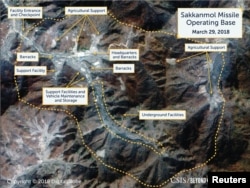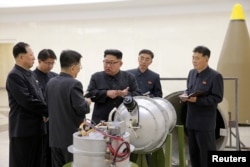President Donald Trump could find himself embracing “strategic patience” on North Korea, an Obama administration approach he once denounced, as nuclear talks with Pyongyang have stalled, analysts say.
A Trump tweet Friday showed the president’s evolving position.
And this policy pivot follows growing concern in Washington that denuclearization of North Korea is likely to be more complicated and take longer than the Trump White House expected. Washington’s talks with Pyongyang have been stalled, and North Korea has not taken concrete steps toward denuclearization.
North Korea abruptly canceled a scheduled meeting with U.S. Secretary of State Mike Pompeo in early November, and U.S. Special Representative for North Korea Stephen Biegun, appointed in August, has yet to meet with his North Korean counterpart.
Satellite images of North Korea throughout the year showed that the country has not stopped its nuclear and missile programs. The most recent image obtained by CNN last week indicated North Korea might be expanding its key long-range missile base with a newly constructed facility.
Not willing to denuclearize
Former U.S. officials and analysts are concerned North Korea’s unwillingness to denuclearize despite the historic summit between the U.S. and North Korea will lead the Trump administration to adopt “strategic patience” as a default policy choice.
Former President Barak Obama adopted the policy of gradually escalating sanctions on North Korea while refusing to negotiate with Pyongyang until it gave up its nuclear weapons program in what came to be known as “strategic patience.”
Trump said “the era of strategic patience is over” last year when dealing with North Korea and took on the policy of “maximum pressure” while engaged in diplomatic talks with Pyongyang this year.
Not a policy, ‘it is a fact of life’
Gary Samore, the White House coordinator for arms control and weapons of mass destruction during the Obama administration, said strategic patience is a result of a policy rather a policy itself.
“For me, ‘strategic patience’ is not a policy,” Samore said. “It is a fact of life.”
According to Samore, the Trump administration is following the same policies of “economic pressure and promises to induce North Korea to accept denuclearization” as the Obama administration had done, with the exception of meeting Kim.
“The biggest difference between Trump and Obama is President Trump’s decision to meet directly with Kim Jong Un to start the negotiation process, the so-called ‘top-down’ approach,” Samore said.
The results are the same
Ken Gause, director of the International Affairs Group, said, “As long as Trump continues down the path of maximum pressure and denuclearization first, he is essentially following the path of strategic patience.”
He continued, “It might not look like strategic patience because of the U.S.-North Korean talks … but the results are the same.”
Gause said the U.S. will drift toward “strategic patience” as long as North Korea’s demand for economic concessions remains unmet.
Less patience, more strategy
Evans Revere, acting assistant secretary at the State Department’s Bureau of East Asian and Pacific Affairs during the George W. Bush administration, said he sees “too much patience and very little strategy in the administration’s approach.”
“Despite clear evidence that [North Korea] is expanding its nuclear and missile capabilities, President Trump has removed the timeline for the North’s denuclearization,” he said.
Revere added, “It’s time for more strategy, less patience, coupled with a healthy dose of action.”
Second summit?
However, Scott Snyder, director of the Program on U.S. Korean Policy at the Council of Foreign Policy, said Trump’s approach toward North Korea differs from the approach that the Obama administration took.
“The Trump administration’s approach involves conscious application of increasing pressure toward North Korea designed to drive toward a decisive point, rather than waiting more passively for North Korea to make a decision,” Snyder said.
Trump has said he is willing to meet Kim for a second summit as early as January or February of next year. Pyongyang, however, has not accepted the summit offer, at least publicly.
On Thursday, North Korea blamed Washington for stalled denuclearization talks, while saying it remains open to discussion and progress.
North Korea’s state-run Korean Central News Agency (KCNA) said, “How can a negotiation train move when North Korea is the only one moving and the U.S. is standing still.” It continued, “We are waiting with patience” for the U.S. to take corresponding measures.










